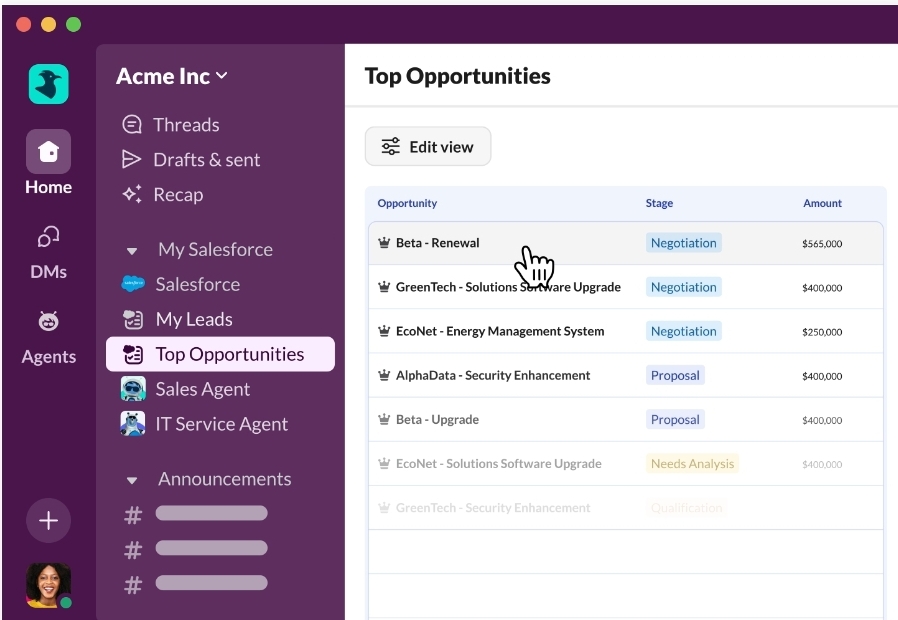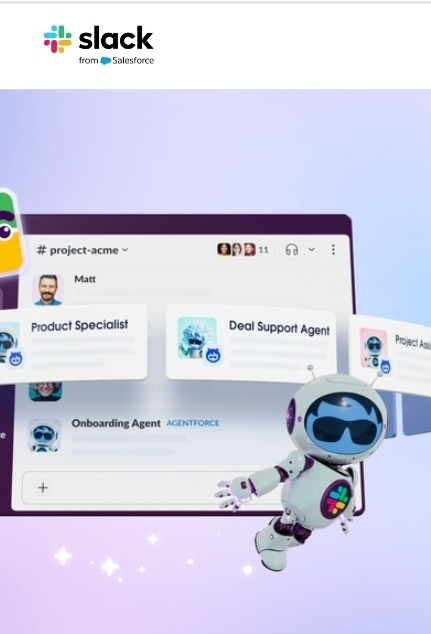From Fragmentation to Flow: How Slack’s Agentic OS is Redefining the Future of Work
Picture this: Your sales team is chasing quarterly targets, but they’re buried in a maze of 11 different applications. Marketing needs customer insights, but they’re hunting through siloed systems. IT is drowning in support tickets, while HR fields the same policy questions repeatedly. Sound familiar? You’re witnessing the modern workplace’s biggest paradox: we have more productivity tools than ever, yet 47% of knowledge workers struggle to find the information they need to do their jobs effectively.
This isn’t just a minor inconvenience. It’s a productivity crisis hiding in plain sight. Workers waste 41% of their time on low-value “work of work,” toggling between applications over 1,200 times daily and losing four hours weekly just to context switching. The financial impact? A staggering $450 billion annually in lost productivity across the U.S. alone.
But what if there was a different way? What if conversations could become the new interface for work itself?
The Conversational Revolution Arrives
At Dreamforce 2025, Slack unveiled its most ambitious transformation yet: evolving from a messaging platform into what they call an “agentic operating system.” This isn’t just another feature update – it’s a fundamental reimagining of how work happens when people, data, applications, and AI agents converge in a single conversational workspace.
“Every company is asking where their agents will live, how they’ll get context, and how to make them useful. Slack is the answer,” declared Denise Dresser, CEO of Slack. The vision is bold: transform scattered, tab-heavy workflows into fluid conversations where natural language becomes the universal interface for enterprise productivity.
The timing couldn’t be more critical. BCG research reveals that companies achieving 30% productivity gains through AI see 50% higher revenue growth. With AI solutions projected to create over $22 trillion in global economic impact by 2030, organizations that master conversational workflows today will define tomorrow’s competitive landscape.
Breaking Down the Conversational CRM Experience
The most striking element of Slack’s transformation is how it’s reimagining Salesforce integration. Instead of forcing users to navigate traditional CRM interfaces, Slack is bringing core business functions directly into conversational flows.
Agentforce Sales in Slack transforms pipeline management from form-filling to conversation. Sales representatives can now strategize with AI agents in the same channel where they collaborate with teammates. Need to update a customer record? Simply ask. Want insights on deal progression? Have a conversation. The system maintains full context across interactions, eliminating the cognitive overhead of switching between CRM tabs and team discussions.
Agentforce IT Service revolutionizes support by embedding assistance directly where employees already communicate. Instead of submitting tickets into black holes, team members get instant help for routine requests like password resets. Complex issues automatically trigger incident channels with relevant context and stakeholders, enabling IT teams to resolve problems faster with complete conversational history.
Agentforce HR Service brings policy guidance and routine requests into natural dialogue. Employees can inquire about benefits, submit time-off requests, or get onboarding assistance through conversation, while HR teams receive contextual handoffs when human intervention is needed.
This conversational approach addresses a core frustration: the context-switching tax that drains productivity. When enterprise functions exist within conversational flows, teams maintain mental continuity while accessing powerful business capabilities.
The Intelligence Layer: Making Every Conversation Smarter
Perhaps the most innovative aspect of Slack’s agentic OS is how it infuses intelligence throughout conversational workflows. The rebuilt Slackbot now functions as a personalized AI companion, connecting to existing tools like Google Drive, Salesforce, and OneDrive to provide contextual insights across conversations and files.
Agentforce Channel Expert represents a particularly clever solution to knowledge management challenges. Instead of expecting employees to remember where information lives or interrupt colleagues with routine questions, this always-on agent surfaces relevant answers based on company information directly within channel conversations. The result: experts focus on strategic work while institutional knowledge remains accessible 24/7.
This approach transforms information discovery from a hunting expedition into a natural dialogue. Research shows that employees spend 59 minutes daily searching for information across different applications. By making knowledge conversational and contextual, Slack eliminates this productivity drain while preserving the collaborative nature of work.
The Platform Play: Connecting Everything Through Conversation
Slack’s platform strategy reveals sophisticated thinking about enterprise AI adoption. Rather than forcing organizations to choose between tools, the new architecture welcomes integration through Real-Time Search API and Model Context Protocol capabilities.
Leading AI companies are already building native Slack experiences. OpenAI’s ChatGPT integration provides conversational access to advanced AI within team workflows. Anthropic’s Claude offers document analysis and web search capabilities directly in channels. Google’s Agentspace creates secure, context-aware agents that understand both organizational data and live Slack conversations.
This ecosystem approach addresses a critical challenge: AI tool sprawl. Instead of juggling multiple AI interfaces, teams can access diverse capabilities through a unified conversational interface. The key differentiator is context – these integrations understand not just individual requests, but the broader conversational and organizational context that makes responses relevant and actionable.
The Employee Experience Transformation
From an employee experience perspective, Slack’s agentic OS represents a profound shift from interface-driven to conversation-driven work. Traditional enterprise software requires users to learn specific navigation patterns, remember where functions live, and context-switch between different mental models.
Conversational interfaces democratize access to sophisticated capabilities. Whether you’re a technical expert or a new hire, asking “What are our top customer retention risks this quarter?” yields the same AI-powered insights. This accessibility is crucial as organizations grapple with hybrid work, diverse skill levels, and the need to onboard people quickly.
The cognitive load reduction is substantial. Instead of remembering which tab contains customer data, which system handles expense reports, or where policy documents live, employees can express needs naturally. The system handles the complexity of routing requests, gathering context, and presenting responses in digestible formats.
The Productivity Science Behind Conversational Work
The productivity gains from conversational workflows aren’t just theoretical. Research from multiple sources reveals the scientific basis for these improvements:
Context Preservation: Unlike traditional interfaces that reset with each new task, conversational AI maintains context across interactions. Teams can build on previous discussions, reference earlier decisions, and maintain cognitive continuity throughout complex workflows.
Reduced App Switching: With employees currently toggling between applications over 1,200 times daily, conversational interfaces eliminate much of this productivity-killing friction. When multiple business functions exist within conversational flows, the mental overhead of task switching dramatically decreases.
Intelligent Anticipation: Advanced conversational systems don’t just respond to requests – they recognize patterns, urgency levels, and context to provide proactive assistance. This shifts interactions from reactive to anticipatory, further accelerating work completion.
Universal Accessibility: Conversational interfaces remove barriers for users with varying technical expertise. The natural language interaction model means that accessing sophisticated AI capabilities requires conversation skills rather than software training.
Real-World Implementation Insights
Organizations implementing conversational workflows are seeing measurable improvements across key metrics. Engine, a travel management company, uses Slack as their operational command center where communication, applications, and operations converge. “We’re building for scale, not speed,” explains Mollie Bodensteiner, Engine’s SVP of Operations. “Slack and Salesforce give us the structure to automate work that slows people down and the flexibility to keep innovating as we grow.”
Vercel’s approach reveals the strategic thinking behind conversational CRM. “We have a goal that 100% of sellers never have to directly enter data in our CRM but only interface via an Agent deployed in Slack,” states Jeanne Grosser, Vercel’s COO. This vision eliminates traditional data entry friction while maintaining comprehensive customer relationship management.
These implementations demonstrate that conversational workflows aren’t just about convenience – they’re about removing structural barriers that prevent teams from operating at their potential.
The Strategic Implications for CX Leaders
For customer experience professionals, Slack’s agentic OS presents both opportunities and considerations. The conversational interface model offers lessons for customer-facing implementations:
Context Continuity: Just as Slack maintains conversational context across business functions, customer experience systems should preserve interaction history and preferences across touchpoints. Customers shouldn’t need to repeat information or restart conversations when moving between channels.
Proactive Assistance: The Channel Expert model demonstrates how AI can anticipate needs and surface relevant information before users ask. CX teams can apply similar approaches to predict customer needs and provide proactive support.
Democratic Access: Conversational interfaces make sophisticated capabilities accessible to users regardless of technical expertise. This principle applies equally to customer-facing systems, where natural language interactions can democratize access to complex services.
Integration Thinking: Slack’s platform approach shows how conversational interfaces can unify disparate systems. CX leaders should consider how conversational workflows might connect customer data, support systems, and business processes into coherent experiences.

The Future of Work is Conversational
Slack’s transformation into an agentic OS signals a broader shift toward conversational work experiences. As Denise Dresser notes, “By making Slack the conversational interface for Salesforce, we’re giving every employee a trusted, unified home for AI and agents — and transforming how work gets done.”
This isn’t just about adding AI features to existing workflows. It’s about reimagining work itself as a continuous conversation between people, data, and intelligent agents. The implications extend far beyond internal operations to customer experience, partner collaboration, and organizational agility.
The companies that master conversational workflows first will enjoy significant competitive advantages. They’ll operate with less friction, make decisions faster, and adapt more quickly to changing conditions. Most importantly, they’ll create work environments where human creativity and AI capabilities amplify each other rather than compete.
Implementation Roadmap for CX Leaders
As conversational workflows become mainstream, CX leaders should consider their own transformation strategies:
Start with High-Friction Processes: Identify areas where employees spend excessive time switching contexts or hunting for information. These are prime candidates for conversational interface improvements.
Focus on Context Preservation: Design systems that maintain conversation history and user context across interactions. This continuity is essential for creating fluid, productive workflows.
Embrace Integration Thinking: Consider how conversational interfaces might unify disparate customer experience tools and data sources into coherent workflows.
Prioritize Accessibility: Ensure that conversational interfaces democratize access to sophisticated capabilities rather than creating new barriers.
Measure Cognitive Load: Track metrics like context-switching frequency, information search time, and task completion rates to quantify improvements.
The future of work isn’t about better applications – it’s about making applications disappear into natural conversation. Slack’s agentic OS provides a compelling preview of this future, where productivity emerges from the flow of conversation rather than the friction of interfaces. For organizations ready to embrace this transformation, the opportunities are as vast as they are immediate.
The question isn’t whether conversational workflows will become dominant – it’s whether your organization will lead or follow this fundamental shift in how work gets done.

